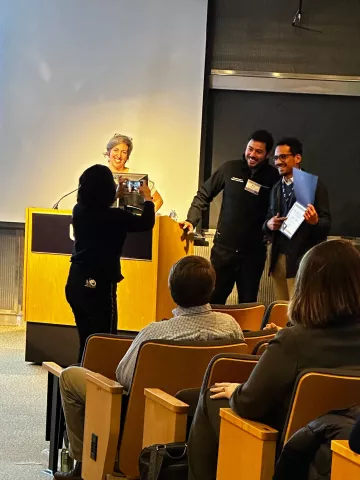
On March 12-13, 2024, members of the Feeley-Liu lab presented at UCSF’s Core Center for Musculoskeletal Biology and Medicine (CCMBM) research retreat. Luke Sang and Cristhian Montenegro placed second with their project “Muscle Regeneration Following Ischemia-Reperfusion Injury” (IRI). This project followed muscle gene expression analysis after IRI. Upregulated Cx43 was studied as a potential key protein for mitochondrial transfer following injury. The Cx43 expression was found to have increased following both injury and beta agonism. In vivo and in vitro experiments suggested that fibro adipogenic progenitor cells donate mitochondria to regenerating fibers after injury and that gap junction protein Cx43 may be involved. When Cx43 was blocked pharmacologically, there was a decrease in mitochondrial transfer and myotube fusion in vitro, indicating that Cx43 may be an important protein that impacts the movement of mitochondria from FAPs to skeletal muscle and aids in its recovery.
Congratulations Luke and Cristhian!
For our other projects, the presentation on Black Box (a device designed to continuously capture the body posture and paw contact force of freely moving mice) was well received. Presented by Nesa Milan, Sankalp Sharma, and Alex Youn, the project focused on assessing the function in musculoskeletal mice models using novel machine learning methods, specifically observing the paw movement of mice across two injury models and four time points.

We also had Ryan Sadjadi present his project, which discussed the application of Black Box to uncover clinically relevant functional data following Ischemia-Reperfusion Injury and protein expression changes. Ryan seeks to address the gap of current IRI models being unable to gather proteomics data immediately post-injury by employing mass spectrometry-based proteomic analysis and, utilizing Blackbox. Combined with machine learning algorithms, this approach enabled Ryan to acquire the objective functional and pain metrics.
